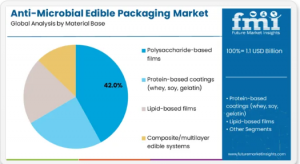Anti-Microbial Edible Packaging Market to Reach USD 3.9 Bn by 2035 — Growth Surges Across Europe, USA, and Saudi Arabia
Edible packaging goes mainstream as Asia-Pacific outpaces global growth; dairy, bakery, and fresh produce sectors embrace natural antimicrobial solutions.
NEWARK, DE, UNITED STATES, November 11, 2025 /EINPresswire.com/ -- The global anti-microbial edible packaging market is undergoing a transformative shift, driven by rising demand for sustainable materials and heightened food safety awareness. With India at the forefront, recording a projected CAGR of 14.9% from 2025 to 2035, the market is expected to reach $3.8 billion globally by 2035. This growth reflects a broader industry pivot toward biodegradable, clean-label packaging that actively preserves food quality while reducing plastic waste.
Edible packaging infused with natural antimicrobial agents—such as essential oils, enzymes, and polyphenols—is gaining traction across dairy, bakery, and fresh produce applications. These innovations not only extend shelf life but also align with consumer preferences for environmentally responsible solutions.
Key Market Insights at a Glance
Global Market Value (2025): $1.1 billion
Forecast Value (2035): $3.8 billion
Decade CAGR: 13.5%
Top Material Segment: Polysaccharide-based films (42% share)
Leading Antimicrobial Agent: Natural plant extracts (46% share)
Primary Applications: Dairy, bakery, fruits, vegetables, meat, and seafood
Fastest-Growing Region: Asia-Pacific, led by India and China
To access the complete data tables and in-depth insights, request a sample report here: https://www.futuremarketinsights.com/reports/sample/rep-gb-24992
Regional Value Spotlight: India’s Strategic Rise
India’s edible packaging market is poised for exponential growth, fueled by government-backed sustainability initiatives and a booming food processing sector. With a CAGR of 14.9%, India is set to outpace global averages, driven by high spoilage rates in fruits and vegetables and increasing demand for clean-label dairy and bakery products.
Local startups are innovating with indigenous materials like rice bran and wheat gluten, while government funding accelerates development of biodegradable coatings. The country’s agricultural diversity and food-tech momentum position it as a global leader in edible packaging adoption.
Regional Overview: Asia-Pacific, North America, and Europe in Focus
Asia-Pacific: Dominates growth with rapid adoption in India and China. Government support and large-scale food retail drive demand for shelf-life-extending coatings.
North America: Strong regulatory frameworks and consumer demand for clean-label products support steady growth, especially in dairy and bakery.
Europe: Sustainability mandates and premium product positioning fuel adoption in Germany and the UK, with advanced nanotech integration enhancing antimicrobial efficacy.
Competitive Landscape: Innovation Meets Scale
The market is moderately fragmented, with a mix of biotech innovators and chemical giants:
Notpla Ltd.: Seaweed-based edible films with natural antimicrobial properties.
Apeel Sciences: Plant-derived coatings for produce preservation.
BASF SE & Dow Chemical Company: Industrial-scale edible film production with polymer expertise.
BioCote Limited & Microban International Ltd.: Specialized antimicrobial technologies for food contact applications.
Kitocoat: Emerging player in enzyme-enhanced coatings and targeted release systems.
These companies are investing in hybrid models that combine material innovation with application-specific antimicrobial delivery, responding to growing demand for scalable, sustainable solutions.
Segment Overview: Materials, Agents, and Applications
Materials: Polysaccharide-based films dominate due to biodegradability and moisture barrier properties. Protein and lipid-based coatings offer compatibility with dairy and bakery.
Antimicrobial Agents: Natural plant extracts lead, followed by enzyme-based systems and nanoparticle-enhanced formulations.
Applications: Dairy and dairy alternatives (36% share), bakery and confectionery, fruits and vegetables, meat and seafood—all benefit from extended shelf life and reduced spoilage.
Market Outlook: Powering the Next Decade
The next ten years will see edible packaging evolve from niche innovation to mainstream adoption. Early growth (2025–2030) will be driven by regulatory approvals and consumer awareness, while the latter half (2030–2035) will benefit from advanced antimicrobial technologies and expanded applications.
Key trends include:
Nanoencapsulation: Controlled release of antimicrobial compounds.
Multilayer Films: Enhanced barrier and preservation capabilities.
Smart Packaging Integration: Real-time freshness monitoring and interactive features.
As food manufacturers seek alternatives to synthetic preservatives and plastic packaging, edible solutions offer a compelling path forward—combining functionality, sustainability, and consumer appeal.
Key Players of Sustainable Label Industry
While the edible packaging market intersects with broader sustainability trends, label innovators are also shaping the future of food packaging:
Sealed Air Corporation: Integrating antimicrobial films with smart labeling.
Microban International Ltd.: Offering dual-function labels with preservation and traceability.
Apeel Sciences: Merging edible coatings with branded sustainability messaging.
These players are redefining how packaging communicates value—both in terms of shelf life and environmental impact.
Full Market Report Available for Delivery. For Purchase or Customization, Please Request Here: https://www.futuremarketinsights.com/checkout/24992
Recent Strategic Developments
University-Industry Collaborations: Accelerating enzyme-based antimicrobial systems.
Retail Trials: Major chains piloting edible coatings across dairy and produce.
Government Funding: India and China investing in food-tech startups focused on biodegradable packaging.
Technology Integration: AI-driven design and automated application systems entering commercial use.
Explore More Related Studies Published by FMI Research:
Twin Neck Bottles Market https://www.futuremarketinsights.com/reports/twin-neck-bottles-market
Paper Recycling Market https://www.futuremarketinsights.com/reports/paper-recycling-market
Freshness Indicator Label Market https://www.futuremarketinsights.com/reports/freshness-indicator-labels-market
About Future Market Insights (FMI)
Future Market Insights, Inc. (FMI) is an ESOMAR-certified, ISO 9001:2015 market research and consulting organization, trusted by Fortune 500 clients and global enterprises. With operations in the U.S., UK, India, and Dubai, FMI provides data-backed insights and strategic intelligence across 30+ industries and 1200 markets worldwide.
Why FMI: https://www.futuremarketinsights.com/why-fmi
Sudip Saha
Future Market Insights Inc.
+1 347-918-3531
rahul.singh@futuremarketinsights.com
Legal Disclaimer:
EIN Presswire provides this news content "as is" without warranty of any kind. We do not accept any responsibility or liability for the accuracy, content, images, videos, licenses, completeness, legality, or reliability of the information contained in this article. If you have any complaints or copyright issues related to this article, kindly contact the author above.

